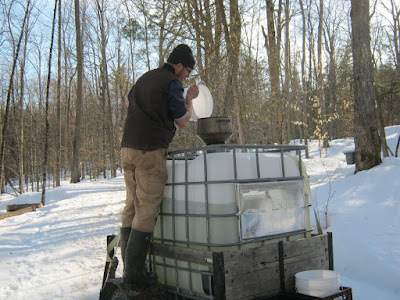Maple Sugaring With Draft Horses
Welp, it's that time of year again!! Mud season? Well, yes, but also maple sugaring season! After joining the collection crew yesterday, I thought I would show you all a little bit of what it is like to make maple syrup the old-fashioned way, with buckets, horses, and a wood-fired evaporator.
First step: Tap the trees. Maple sap "runs" when you have freezing nights and warm days. The simplified reason for this is that during the day the warm temperatures create pressure in the tree, drawing the sugary sap up the tree. In the evening when it begins to freeze again the tree sucks all of its sap back into its roots. In this process, it flows past your tap holes and out your tap into the bucket. It looks a little something like this:
You want to do this a couple of days before the sap starts to flow so you don't miss any of this precious sap. It takes more than 40 gallons of maple sap to make one gallon of maple syrup so you need A LOT of it and you don't want to miss a single drop. Recently, buckets have fallen out of favor because you have to go visit every tree every time the sap runs and it can be a lot of walking around, especially if you have a couple of thousand trees tapped. Instead, large syrup producers have begun to use rubber tubing connected to each tap and running downhill into a tank. While you have to set up the tubing and replace it often, when it comes time to sugar all you have to do is draw off of your tank and boil it down. Some producers are even using vacuum pumps to get the sap out of the tree. They claim that the vacuum merely equalizes the pressure in the tree and the tube so that the sap can flow unhindered, but I think this method is a little too on the greedy side. They say it doesn't hurt the tree at all but I'm still skeptical. Plus, rubber tubing just means more plastic in the environment. Not to mention that it makes it a nightmare to take a walk through the woods without being clotheslined. Traditionally, people carved wooden taps from hollow sticks and collected sap in waterproof birch bark containers. To waterproof them they often used pine pitch to seal the edges shut. I recently wrote a post about making pine pitch, to read more about it click HERE. They then boiled the sap by dropping hot rocks into either the birch bark containers or into huge wooden coal burned bowls. Either way, it took a very long time to boil the sap down all the way into dry sugar that could be stored for long periods of time.
Once the sap is running we go out with two horses and a big water buffalo tank, a bunch of people and 5 gallon buckets. You have one teamster, a pourer who grabs the buckets from the runners and pours the sap into the tank, and a handful of runners who have two 5 gallon buckets and go to each tap collecting the sap and bringing it back to the tank. We also use a header to stand in front of the horses when they are stopped and keep them from moving around too much while people are trying to pour the sap in the tank (our horses are not as patient as they should be, and Belle really hates standing in mud). Here's a video of me driving the tank wagon with Belle (black horse) and Valentine (brown horse):
Here's the collection crew:
Once we've collected all of the sap, we bring it back to the sugar house where it gets boiled down for hours and hours and hours until we have a couple gallons of pure Vermont maple syrup! Yum!
Testing to see if the syrup is "sheeting" yet. This means that it is dripping off in long sheets rather than individual drops and is how you know that the syrup is thick enough and ready to be siphoned off.
Stoking the fire.
Late nights in the sugar house often mean lots of great music.
The earth does not belong to us. We belong to the earth.
Disclaimer: This blog is just my own opinion, nothing more. While I try my hardest, everything may not be completely accurate or complete. Sorry, I'm only human, so do not hold me accountable for anything you do to harm yourself or the world around you. I do make money from this blog (seriously not very much at all guys). If you click on any of the links in my blog I may make money from it. I'm not sponsored by any of these people I just honestly love these products and want to give you the resources to find them. I am not a medical practitioner; consult a health professional before using any herbal remedies. I am not claiming to diagnose, treat, prevent, or cure any ailment.













